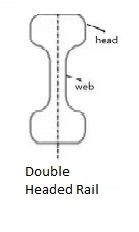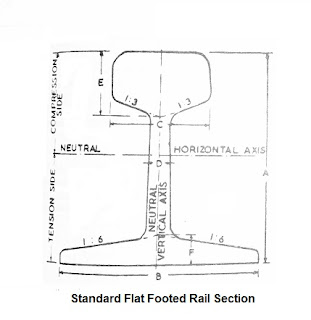Table of Contents
What is Rails?
Rails are steel girders placed an end to end to provide a level and continuous surface for the movement of trains.
Functions of Rails
- The rails provide the level and continuous surface for the movement of trains.
- The rails provide a smooth pathway to trains. The pathway has very low friction. The friction between the wheels of train and steel of the rails is about 20% of the friction between the pneumatic tyres and metalled roads.
- The rails serve as a lateral guide for the running of wheels.
- The rails carry the stresses developed due to vertical loads transmitted to it through axles and wheels of the rolling stocks, due to braking forces and thermal stresses etc.
- The rail transmits the heavy load of rolling stock etc to the large area of formation through sleepers and ballast.
Types of Rails
Double Headed Rail
Originally the rails used were double-headed made of I section or Dumbbell section as shown in the figure. The idea was that when the head of the rail is worn-out during the service period, the rail could be inverted and reused without increasing any extra expenditure.

Such rails need to be supported on chairs that rest on sleepers. But later on, it was found that during the service the bottom table of the rail was dented by the long and continuous contact with the chair to such an extent that it was impossible to reuse it. This led to the development of bull-headed rail.
Bull Headed Rail
The bull-headed rail is almost similar to the double headrail. The only difference between the double-headed rail and Bull headrail is that in Bull-headed rail more metal is added to the head to allow greater wear and tear.

The lower head or table was kept of just sufficient size to be able to withstand the stress be induced by the moving loads. The rail also required a chair for fixing it to the sleepers. This proved the greater drawback of this rail.
Flat-Footed Rail

To remove the above drawbacks, Charles Vignoles developed an inverted T shaped section known as flat-footed rail in 1936. Flat-footed rail is also known as Vignole rail. It has the following advantages over double-headed and bull-headed rails.
Advantages of Flat-Footed Rails
- For fixing flat-footed rails to sleepers, no chairs are needed. The foot of the rail may be spiked direct to the sleepers. This affects the economy to a great extent.
- For the same weight, this rail is stronger vertically and laterally both than Bull-headed rails.
- It is cheaper than Bull-headed rails.
- It requires less fastening than Bull-headed rail.
- F.F. rail gives better stability to the track as these rail distribute rolling stock load over a large number of sleepers.
- F.F. rails develop fewer kinks and maintain a more regular top surface than B.H. rails.
- F.F. rail gives longer life to the track and reduces maintenance cost.
The F.F. rails have been widely accepted throughout the world. About 90% track length of the entire world has been laid with F.F. rails. It has also been standardised on Indian Railways.
If you found this information helpful please don’t forget to share it with your friends.